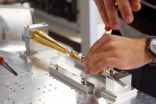(Press-News.org) CHAMPAIGN, Ill. — Scientists have scoured cow rumens and termite guts for microbes that can efficiently break down plant cell walls for the production of next-generation biofuels, but some of the best microbial candidates actually may reside in the human lower intestine, researchers report.
Their study, reported in the Proceedings of the National Academy of Sciences, is the first to use biochemical approaches to confirm the hypothesis that microbes in the human gut can digest fiber, breaking it down into simple sugars in order to ferment them into nutrients that nourish human cells. These findings have significance for human health but also for biofuels production, since the same sugars can be fed to yeast to generate ethanol and other liquid fuels. The human microbes appear to be endowed with enzymes that break down a complex plant fiber component more efficiently than the most efficient microbes found in the cow rumen, the researchers report.
Their work in cows led the researchers to the human microbes, said University of Illinois animal sciences and Institute for Genomic Biology professor Isaac Cann, who led the new analysis with his colleagues, animal sciences professor Roderick Mackie and M.D./Ph.D. student Dylan Dodd. Cann also is a microbiology professor and a principal investigator at the Energy Biosciences Institute. Dodd is now at Stanford University.
"In looking for biofuels microbes in the cow rumen, we found that Prevotella bryantii, a bacterium that is known to efficiently break down (the plant fiber) hemicellulose, gears up production of one gene more than others when it is digesting plant matter," Cann said.
When searching a database for similar genes in other organisms, the researchers found them in microbes from the human gut. The team focused on two of these human microbes, Bacteroides intestinalis and Bacteroides ovatus, which belong to the same bacterial phylum as Prevotella from the cow.
"We expressed the human gut bacterial enzymes and found that for some related enzymes, the human ones actually were more active (in breaking down hemicellulose) than the enzymes from the cow," Cann said.
When the researchers looked more closely at the structure of the human enzymes, they saw something unusual: many single polypeptide (protein) chains actually contained two enzymes, one of which was embedded in the other. Further analysis of the most important protein revealed that the embedded component was a carbohydrate-binding module (CBM), which, as its name implies, latches onto carbohydrates such as hemicellulose. This enzyme shreds the plant fiber hemicellulose so that other enzymes can work on it to break it down into its unit sugars.
Working with U. of I. biochemistry professor Satish Nair, the researchers also noticed that the CBM "put a kink" in the fiber when it bound to it. This bending action may bring the fiber close to the other enzyme in the protein so it can get to work breaking the bonds between the sugars. Further research is needed to confirm this hypothesis, Cann said.
The study points to human microbes as a potentially potent source of microbes that can aid in biofuels production, Cann said.
"In addition to finding microbes in the cow rumen and termite gut, it looks like we can actually make some contributions ourselves," he said. "And our bugs seem to have some enzymes that are even better than those in the cow rumen."
INFORMATION:
The Energy Biosciences Institute (EBI) and the U.S. Department of Agriculture funded this research. The EBI is a public-private collaboration funded with $500 million for 10 years from the energy company BP and includes researchers from Illinois, the University of California at Berkeley and the Lawrence Berkeley National Laboratory.
Editor's notes:
To reach Isaac Cann, call 217-333-2090; email icann@illinois.edu.
The paper, "Xylan utilization in human gut commensal bacteria is orchestrated by unique modular organization of polysaccharide-degrading enzymes" is available online or from the U. of I. News Bureau. END
Search for better biofuels microbes leads to the human gut
2014-09-23
ELSE PRESS RELEASES FROM THIS DATE:
Results of the 1st EORTC Cancer Survivorship Summit
2014-09-23
A special issue of the European Journal of Cancer presents detailed reports on the wide range of research presented during the 1st EORTC Cancer Survivorship Summit held this past January in Brussels, Belgium.
Early diagnosis, targeted therapeutics, and more personalized multimodal treatments has boosted survival rates of patients with cancer and led to a large and rapidly increasing number of cancer survivors. Despite this good news, cancer survivors are often confronted with a broad spectrum of late adverse treatment effects and some must also deal with societal discrimination ...
Nanotubes help healing hearts keep the beat
2014-09-23
Carbon nanotubes serve as bridges that allow electrical signals to pass unhindered through new pediatric heart-defect patches invented at Rice University and Texas Children's Hospital.
A team led by bioengineer Jeffrey Jacot and chemical engineer and chemist Matteo Pasquali created the patches infused with conductive single-walled carbon nanotubes. The patches are made of a sponge-like bioscaffold that contains microscopic pores and mimics the body's extracellular matrix.
The nanotubes overcome a limitation of current patches in which pore walls hinder the transfer ...
Study uncovers genetic driver of inflammation, uses it to prevent and treat liver cancer
2014-09-23
Inflammation has been shown to be a driving force behind many chronic diseases, especially liver cancer, which often develops due to chronic inflammation caused by conditions such as viral hepatitis or alcoholism and has relatively few effective treatment options. Now, scientists at Virginia Commonwealth University Massey Cancer Center have demonstrated for the first time in preclinical studies that blocking the expression of a gene known as astrocyte elevated gene-1 (AEG-1) halts the development and progression of liver cancer by regulating inflammation. This research ...
Mother-infant bed sharing messaging should be tailored, according to UGA researcher
2014-09-23
Athens, Ga. – Bed sharing, a practice where mother and infant sleep on the same surface, remains popular all over the world despite potential health risks for the infant. According to a new University of Georgia study, bed sharing can likely be decreased if public health officials tailor messaging to their unique population.
Trina Salm Ward, assistant professor in the UGA School of Social Work and assistant professor of health promotion and behavior in the College of Public Health, reviewed literature on bed sharing in "Reasons for Mother-Infant Bed-Sharing: A Systematic ...
Interdisciplinary research team finds method for more precise diagnosis of pneumonia
2014-09-23
WASHINGTON (Sept. 23, 2014) — A patient survives life-threatening trauma, is intubated in the intensive care unit (ICU) to support his or her affected vital functions, starts to recover, and then develops pneumonia. It's a scenario well-known to physicians, who understand that the development of ventilator-associated pneumonia in critically ill patients often results in significant morbidity, mortality, and additional health care costs.
An interdisciplinary team of George Washington University (GW) researchers are investigating more accurate and rapid methods of identification ...
Life, liberty, and the pursuit of healthcare?
2014-09-23
The Affordable Care Act — "Obamacare" — was signed into law in 2010 and promised the largest overhaul of the U.S. healthcare system since the 1960s. Designed to provide medical care to uninsured Americans, it has been widely decried as an unwarranted intrusion into the affairs of private businesses and individuals.
However, an independent comparative study of healthcare systems in six Western countries, published last month in Social Science and Medicine, supports a move away from privatized medicine toward state-sponsored healthcare systems. In her research, Dina Maskileyson ...
Virtual water: Tracking the unseen water in goods and resources
2014-09-23
Alexandria, Va. — "Virtual water" was coined in 1993 to help explain why long-predicted water wars driven by water and food security had not occurred among the arid nations of the Middle East and North Africa. The virtual water notion refers basically to the total amount of freshwater, either from rainfall or irrigation, used in the production of food commodities, including crops and fodder-fed livestock, or other goods and services — agricultural, industrial or otherwise. Taking root in the late 1990s across a range of disciplines, the concept has since expanded and evolved.
Today, ...
Could suburban sprawl be good for segregation?
2014-09-23
DURHAM, N.C. -- Racially and economically mixed cities are more likely to stay integrated if the density of households stays low, finds a new analysis of a now-famous model of segregation.
By simulating the movement of families between neighborhoods in a virtual "city," Duke University mathematician Rick Durrett and graduate student Yuan Zhang find that cities are more likely to become segregated along racial, ethnic or other lines when the proportion of occupied sites rises above a certain critical threshold -- as low as 25 percent, regardless of the identity of the ...
Safe passages into adulthood: Preventing gender-based violence and its consequences
2014-09-23
WASHINGTON, DC -- Gender-based violence affects the physical and mental health of girls and boys, men and women worldwide. A recent study by researchers from the Institute for Reproductive Health at Georgetown University addresses the challenge of developing effective strategies to change inequitable and harmful social norms that result in gender-based violence.
Inequitable gender norms are not only related to domestic violence, but also to other behaviors such as multiple sexual partners, smoking and alcohol abuse which lead to poor health outcomes.
The findings ...
A piece of work demonstrates various ways for controlling light in the terahertz frequency
2014-09-23
This news release is available in Spanish.
The Journal of Optics has devoted the front page of its special edition on Mid-infrared and THz Photonics to the work produced by the NUP/UPNA-Public University of Navarre researchers Víctor Pacheco-Peña, Víctor Torres, Miguel Beruete and Miguel Navarro-Cía (former student currently working at Imperial College London), together with Nader Engheta (University of Pennsylvania), one of the world's leading experts in metamaterials. In their research they have proposed various devices capable of redirecting electromagnetic waves ...




